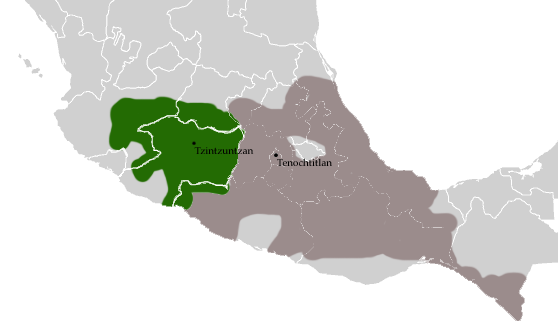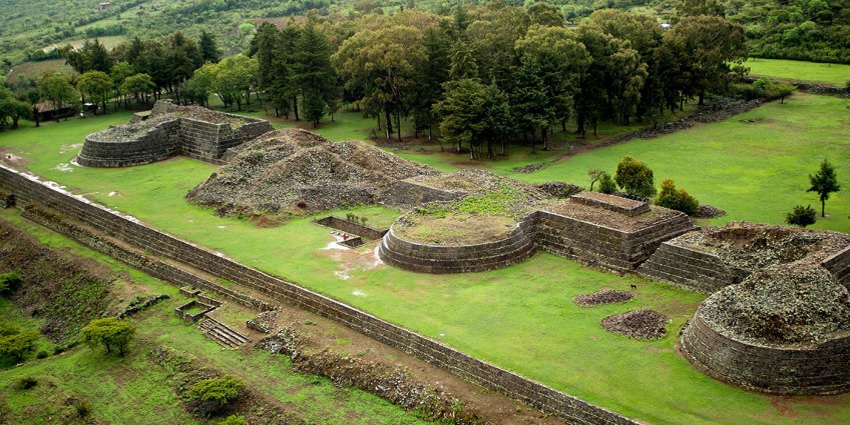Wed 18 Sep 2019

https://www.ancient.eu/Tarascan_Civilization/
Rituals
Structure & Symbolism
One important part of the Pre-Columbian Tarascan empire’s culture is their relationship with their rituals. One specific ritual the Tarascan people participated in was called a “Cúrpite”. Cúrpite is translated to “those who come together, attach themselves, or join in”. The translation represents the importance of inclusion at the celebrations that these Cúrpites are a part of. The Cúrpites are celebrated usually starting on December 8, the date of the Immaculate Conception and go until February 2nd, the raising of the Christ Child. When participating in the Cúrpites, the participants are typically inebriated, dressed wearing typical clothing in untypical ways, and parading through people homes. It was common for the participators to wear masks, cloaks, headdresses, aprons and other accessories. The clothing worn during the Cúrpite and the time of year the Cúrpite is performed, is thought to represent the Three Kings or the “Santos Reyes”. The dances are supposed to be portrayed as wild and disorderly, all while maintaining their traditions as a culture. The Tarascans were however polytheistic and worshipped gods and goddesses represented by the sun, moon, warfare, hunting, rain, childbirth, and fertility.

https://www.google.com/url?sa=i&rct=j&q=&esrc=s&source=images&cd=&cad=rja&uact=8&ved=2ahUKEwjSprDNmd3kAhXT7Z4KHYjMDkMQjB16BAgBEAM&url=http%3A%2F%2Fetc.ancient.eu%2Finterviews%2Fmeet-the-tarascans-fierce-foes-of-the-aztecs%2F&psig=AOvVaw1wKv72fAS6a7aRm6xF0O_p&ust=1568992629780838
Gender, Hyper-masculinity, and Class
In the Cúrpite, the typical participants are young, drunk bachelors. The men spend a lot of money on expensive traditions, just to participate in rituals, and the money spent on these events caused controversy in communities, mostly between men and women. Men were the main participants in the events, while women were expected to cook food, prepare for parties, and do the other preparatory work, while men dressed up, got intoxicated, and paraded around town. Men were also represented with a high level of masculinity. A man’s masculinity was symbolized by a strutting rooster, and he would dress up in a headdress, a colorful bibs, aprons, and a cloak that resembled a rooster’s wings. This represented a more masculine factor in the Tarascan population, opposed to many other tribes that valued a women’s role in communal affairs and were sometimes even thought of as matriarchal. Men had the majority of control, especially in the nobility and royal family. The royal family his nobility were the elites of the land. They were kept in a completely separate category as the poor people of the community, and made sure their lives overlapped as little as possible. The royalty had the power to distribute land and owned all profitable parts of the land as well. Suppression of the poor was a common theme, and there was little possibility of increasing your social class, due to the inherent power of the royals.
Geographical Impact
These rituals were most evident in the communities of the Tarascan people. The most significant community to the Cúrpite ritual was Tzintzantzun. Tzintzantzun was the capital of the Tarascan empire, and it held a lot of value to the rituals that took place in Tzintzuntzan. One reason Tzintzntzun was so relevant to the Cúrpite was because it was the main cultural epicenter for the Tarascan people. It was where most events were occuring and attracted the biggest following of people. The rituals were tied to the land because the land and the rituals had lived together for the history of the Tarascan people. Tzintzuntzán was also the religious center for the Tarascans, which made it even more common to find rituals like the Cúrpite around town.
Tzintzuntzán
Geography
Tzintzuntzán at its prime was in the heart of the Michoacán region in ancient Mexico. The Michoacán region was made up of different kinds of landscape scaling from a low land area with many small lakes , to dense forestland, to deep valleys of the dessert and to ranges of mountains and volcanos. The Tarascans found that they would prefer their homes in the dense forest land rather than the excruciating heat.In the height of the Tarascan dominance, Tzintzuntzán had a population of 35,000 people, making it the second largest community at this time in MesoAmerica. Geographically they were close to the Aztecs, which lead to disputes and communication between cultures. The city is located right on the banks of Lake Patzcuaro. At the time Tzintzuntzan had a plethora of valuable gems and minerals most commonly obsidian, jade, onyx, serpentine, and copal, along with many more. The mountainous basin made the region a perfect land for mines, which was one successful part of the Tarascan economy. Tzintzuntzan was where the king resided, which meant that was where all political, religious, and economic affairs were handled.

https://mexicanroutes.com/tzintzuntzan-ruins/
Urban Planning
Tzintzuntzán, at its peak occupied 6.74 square kilometers, or 2.60 square miles, and had a population between 25 – 35,000 people. To further discuss the urban planning that went into the empire, one must first define ‘zoning.’ Zoning is the different uses of land within a given area, or more plainly, the determined purpose of that space. Through the archeological digs, one can discern that a number of these ‘zones’ existed within the city, namely public spaces, such as, religious and educational spaces. There were also industrial and commercial zones, places where items were crafted, and then taken to a different location to be bought and sold. Within Tzintzuntzán evidence also suggests remnants of residential, burial, agricultural, and recreational zones. Another important facet is the proof of defensive zones, such as walls and ditches. Tzintzuntzán was a bustling hub of activity, whether it be more intellectual or relaxation based. The planning was both respectful to the lands and consciousness of the purpose the spaces served.
Significance upon Empire
While the Tarascan empire was made up of several diverse and vibrant cities, Tzintzuntzán claimed the title of capital, and additionally, was the key urban center within the empire. The city had many appealing characteristics to outsiders, one being the fact that the king resided there. Tzintzuntzán was home to a hospital specializing in wounds received during battle. On the opposite end of the activity spectrum, Tzintzuntzán also had a zoo that likely housed eagles, lions, and tigers among other animals. This key urban center held numerous kinds of appeal to those under Tarascan leadership and those beyond.
Bibliography
Bishop, Joyce M. “”Those Who Gather In”: An Indigenous Ritual Dance in the Context of Contemporary Mexican Transnationalism.” The Journal of American Folklore 122, no. 486 (2009): 391-413. http://www.jstor.org/stable/40390079.
Malmstrom, Vincent. “Geographical Origins of the Tarascans.” Geographical Review 85, no. 1 (1995): 31-40.
The Oxford Encyclopedia of Mesoamerican Cultures: The Civilization of Mexico and Central America. David Carrasco, ed. Vol. 3. Oxford: Oxford Univ. Press, 2001.
Pollard, Helen Perlstein. “An Analysis of Urban Zoning and Planning at Prehispanic Tzintzuntzan.” Proceedings of the American Philosophical Society 121, no. 1 (1977): 46-69. http://www.jstor.org/stable/986566
Williams, Eduardo. “Pre-Hispanic West Mexico: A Mesoamerican Culture Area.” Foundation for the Study of Mesoamerican Studies. http://www.famsi.org/research/williams/index.html